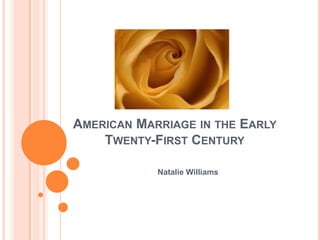
Sociology 125 article presentation copy (2)
- 1. AMERICAN MARRIAGE IN THE EARLY TWENTY-FIRST CENTURY Natalie Williams
- 2. MARRIAGE 1890-2002 In 1890’s Men married at around age 26 Women at age 22 In 1950’s Men married at 23 Women at age 21 In 2002 Men marry around age 26-27 Women marry around 25-26
- 3. COHABITATION Evolving phenomenon Same Sex couples more likely to live together Trial Marriage see what it’s like to live with another before you marry them Normally don’t last long Half will end up splitting up Can be through break up of boyfriend/girlfriend Through marriage
- 4. TWO PARENTS VS. ONE PARENT 1960-2002 Two parent families start to decline 62 percent One parent families increases 27 percent Neither parent 4 percent
- 5. CURRENT SITUATION OF MARRIAGE 16% of people agreed main purpose of marriage is to have children 94% want a soul mate Marriage remains a popular among the low and middle class whether they can afford it or not Homosexual couples want marriage More apparent in U.S than in other developed Western Nations
- 6. INTO AND OUT OF MARRIAGE 517 divorces per 1,000 marriages Experience going in and out of more marriages than any other Western Nations Children are more likely to be around multiple unions U.S has twice as many unions as Sweden does Cohabitating can increase the number of unions a person has
- 7. MARRIAGE IN A NEW LIGHT Marriage is more optional People can choose to have families Marriage is based more on the individual Less centered on the children With less children, less competition for parents attention With people having multiple unions, the children are placed in more unstable situations Although, people divorce or break up, marriages continue to thrive in U.S.
- 8. CRITICAL THINKING QUESTION 20 years from now, do you think people will still value marriage or do you think it eventually will be a thing of the past?
